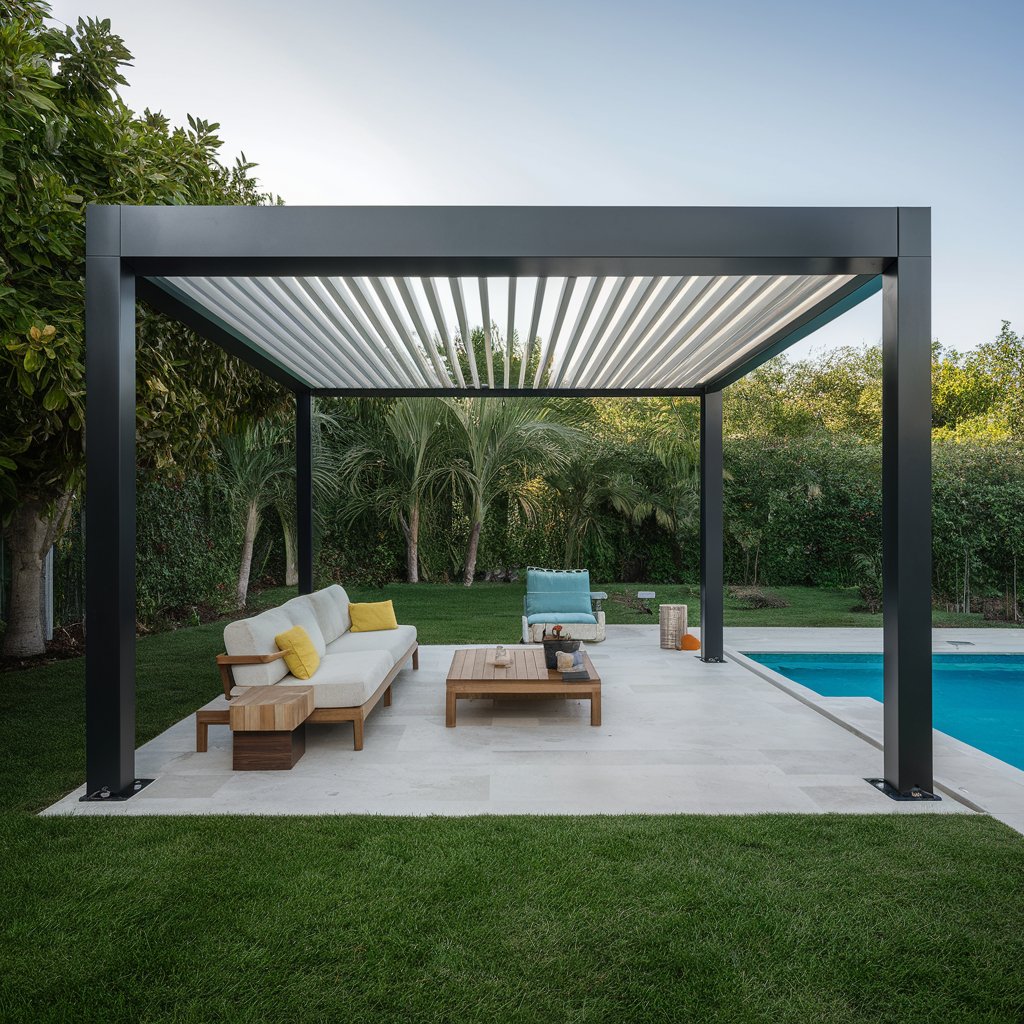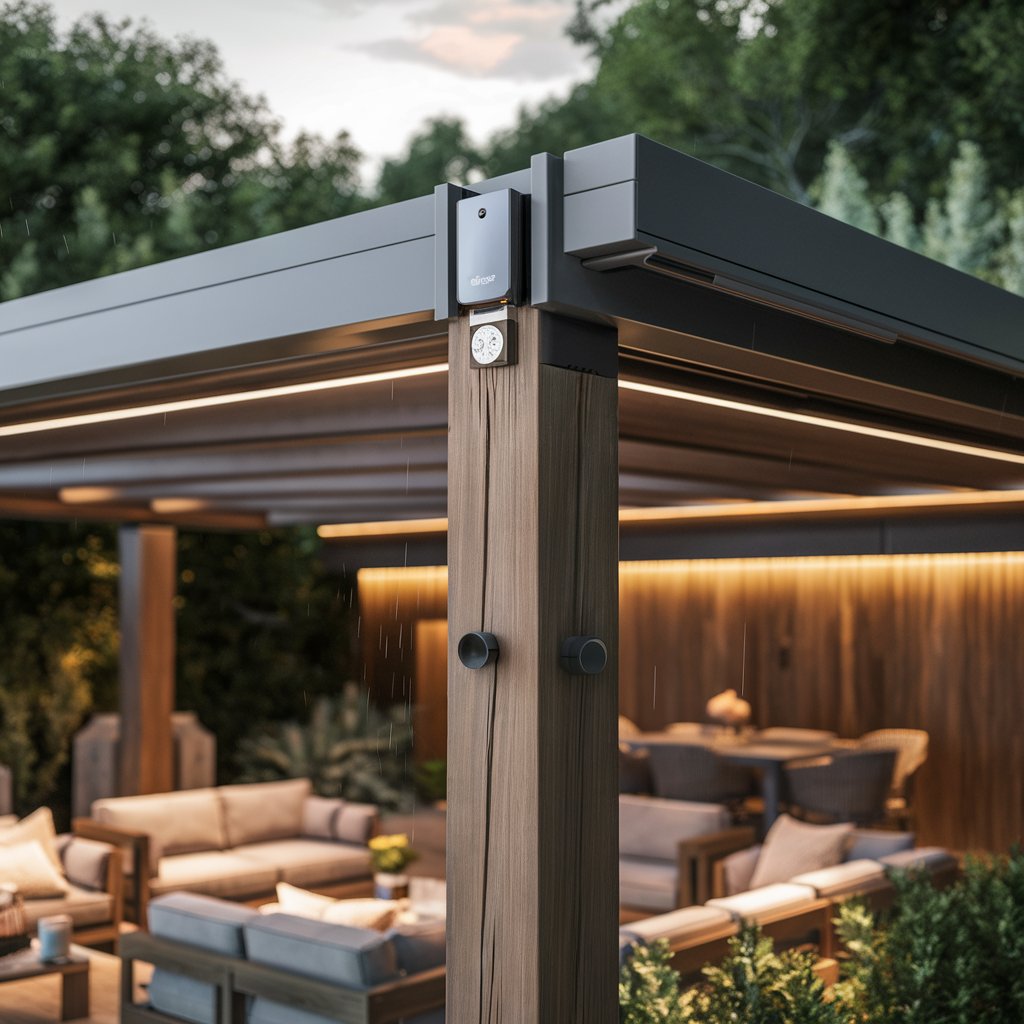Long-lasting Pergolas, with their blend of form and function, provide an elegant enhancement to any outdoor space. These structures offer both shade and a framework for climbing plants, creating a focal point that can transform gardens, patios, and yards. However, to ensure your pergola stands the test of time, regular maintenance is crucial. This comprehensive guide will delve into detailed maintenance tips and best practices for keeping your pergola looking its best and structurally sound for many years.
1. Regular Cleaning and Debris Removal of Long-Lasting Pergolas
One of the most basic yet essential tasks in maintaining a pergola is regular cleaning. Over time, dirt, leaves, and other debris can accumulate, leading to potential damage.
Removing Debris
Regularly clear away leaves, twigs, and other debris that can accumulate on top of the pergola. This is particularly important in autumn when leaves are falling more frequently. Use a broom or a blower to remove the debris from the roof and the joints of the pergola.
Washing the Structure
Periodically washing the pergola helps to remove dirt, mildew, and other contaminants that can cause damage over time. Use a mild detergent mixed with water to wash down the pergola. For tougher stains or mildew, a solution of water and vinegar can be effective. Rinse thoroughly with a garden hose to remove all soap residues, as they can attract dirt and grime if left on the surface.
For a deeper clean, consider using a pressure washer. However, be cautious with the pressure setting to avoid damaging the wood or paint. If your pergola is made of wood, ensure it dries completely after washing to prevent moisture-related issues.
2. Inspecting for Damage
Regular inspections are key to catching potential problems before they become serious issues. This involves looking for signs of rot, decay, cracks, and other forms of damage.
Checking for Rot and Decay
Wooden pergolas are especially susceptible to rot and decay. Regularly inspect the wood for any soft spots, discoloration, or areas that appear swollen. These can be signs of rot, which can spread quickly if not addressed. Pay special attention to the base of the pergola where the wood meets the ground, as this area is most prone to moisture exposure.
For metal pergolas, look for signs of rust, especially at joints and fasteners. Rust can weaken the structure over time, so it’s important to treat it promptly.
Examining Fasteners
Bolts, screws, and other fasteners can loosen over time due to weather changes and regular use. Ensure that all fasteners are secure and tighten any that have become loose. Replace any that are rusted or damaged to maintain the structural integrity of the pergola.
Looking for Cracks
Cracks can develop in both wooden and metal pergolas. For wood, check for splits or cracks in the beams and posts. Small cracks can be filled with wood filler, but larger cracks may require replacing the affected section. For metal pergolas, inspect for any cracks or fractures, particularly at weld points. Address these issues promptly to prevent further damage.
3. Protecting the Wood
For wooden pergolas, protection from the elements is crucial to extend their lifespan. This involves sealing, staining, and using quality materials for repairs and maintenance.
Sealing and Staining
To protect a wooden pergola from the elements, apply a sealant or stain every 1-3 years. Sealing the wood helps to prevent moisture from penetrating and causing rot. Choose a high-quality, UV-resistant sealant to protect the wood from sun damage. Staining not only enhances the appearance of the wood but also adds an extra layer of protection.
Before applying a new coat of sealant or stain, clean the pergola thoroughly and allow it to dry. Sand any rough spots to ensure a smooth, even application. Follow the manufacturer’s instructions for the best results.
Using Quality Materials
When repairing or maintaining your pergola, use high-quality, weather-resistant materials. For example, use stainless steel or galvanized fasteners to prevent rust. Choose rot-resistant wood types, such as cedar or redwood, for any replacements. Investing in quality materials can significantly extend the lifespan of your pergola.
4. Long-Lasting Pergolas Maintenance
Metal pergolas require specific maintenance to prevent rust and ensure longevity. This involves rust prevention, treating rust spots, and lubricating moving parts.
Rust Prevention
Metal pergolas can rust over time, especially in humid or coastal areas. To prevent rust, apply a rust-resistant primer and paint. Regularly inspect the pergola for signs of rust and treat any areas immediately. Sand down rust spots to remove the affected metal, then apply a rust inhibitor before repainting.
For added protection, consider using a clear coat or sealant designed for metal surfaces. This provides an additional barrier against moisture and other corrosive elements.
Lubricating Moving Parts
If your pergola has any moving parts, such as a retractable canopy or adjustable louvers, ensure these are well-lubricated to prevent wear and tear. Use a silicone-based lubricant, which is water-resistant and won’t attract dirt and grime. Regular lubrication helps to keep the moving parts functioning smoothly and extends their lifespan.
5. Maintaining Climbing Plants for Long-Lasting Pergolas
Climbing plants can add beauty and shade to a pergola, but they require careful management to prevent damage to the structure.
Pruning Regularly
If you have climbing plants growing on your pergola, prune them regularly to prevent them from becoming too heavy and damaging the structure. Overgrown plants can add significant weight and stress to the pergola, leading to potential structural issues. Regular pruning helps to maintain a healthy balance and prevents overgrowth.
Monitoring Growth
Ensure that the plants are growing evenly and not putting too much weight on one side of the pergola. Redirect growth as necessary to maintain balance. Use plant ties or trellis systems to support the plants and distribute their weight evenly. Be cautious not to damage the pergola when tying or training the plants.
6. Seasonal Maintenance
Different seasons bring different challenges for pergola maintenance. Adapting your maintenance routine to the changing seasons helps to keep the pergola in good condition year-round.
Winter Preparation
Before winter, clean your pergola thoroughly and make any necessary repairs. For areas with heavy snowfall, consider adding support beams to help bear the extra weight. Remove any climbing plants if they are not evergreen, as their weight combined with snow can cause damage.
If your pergola is made of wood, apply a fresh coat of sealant or stain to protect it from moisture. For metal pergolas, ensure all rust spots are treated and the structure is properly coated with rust-resistant paint.
Spring Check
After winter, inspect your pergola for any damage caused by snow or ice. Check for cracks, splits, or rot in wooden pergolas and rust in metal pergolas. Make any needed repairs before the growing season begins. Clean the pergola thoroughly and consider reapplying sealant or paint if necessary.
7. Professional Inspection on Long-Lasting Pergolas
While regular DIY inspections and maintenance are essential, consider having a professional inspect your pergola every few years. Professionals can identify potential issues that you might overlook and provide expert maintenance tips. They can also perform more complex repairs and treatments that may be beyond the scope of DIY maintenance.
8. General Tips
In addition to the specific maintenance tasks mentioned above, there are some general tips to help you maintain your pergola effectively.
Avoid Climbing
Discourage children or pets from climbing on the pergola to prevent accidental damage. Climbing can stress the structure and lead to cracks, splits, or other forms of damage.
Shade Protection
If your pergola is exposed to direct sunlight for most of the day, consider adding a shade cloth or canopy to protect it from UV damage. This helps to prevent fading, cracking, and other sun-related issues. Choose a UV-resistant shade cloth or canopy for the best protection.
Detailed Maintenance Schedule for Long-Lasting Pergolas
Creating a detailed maintenance schedule can help you stay on top of the various tasks required to keep your pergola in excellent condition. Here is a suggested maintenance schedule:
Monthly
- Inspect for debris: Remove leaves, twigs, and other debris.
- Check fasteners: Ensure bolts, screws, and other fasteners are secure.
- Prune climbing plants: Keep growth under control.
Quarterly
- Wash the pergola: Clean with a mild detergent and water.
- Inspect for damage: Check for cracks, rot, rust, and other forms of damage.
- Lubricate moving parts: If applicable, ensure smooth operation.
Annually
- Apply sealant or stain: Protect wooden pergolas from the elements.
- Treat rust spots: For metal pergolas, sand down rust and repaint.
- Professional inspection: Consider having a professional check the pergola.
Seasonal
- Winter preparation: Clean and reinforce the structure before winter.
- Spring check: Inspect for winter damage and make necessary repairs.
Conclusion
Maintaining a pergola requires regular attention and care, but the effort is well worth it. A well-maintained pergola not only enhances the beauty of your outdoor space but also provides a functional and enjoyable area for relaxation and entertainment. By following these detailed maintenance tips and keeping a consistent schedule, you can ensure that your pergola remains a stunning and durable feature of your landscape for many years to come.
Remember, the key to long-lasting pergola maintenance is prevention. Regular inspections, cleaning, and timely repairs can prevent minor issues from becoming major problems. Whether your pergola is made of wood or metal, incorporating these maintenance practices into your routine will help you enjoy its beauty and functionality for decades.


